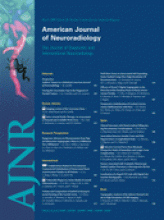The article by Backes et al1 is the first report showing that the spinal cord blood supply during open aortic surgery may crucially depend on the collateral arteries. We agree that demonstration of the collaterals is important when segmental arteries connecting directly to the Adamkiewicz artery (AKA) are occluded or are highly stenosed. However, our study focused on comparison of intra-arterial CT angiography (CTA) with intravenous CTA to detect the AKA in the same scanning protocol.2
CTA also can visualize the collateral arteries.3,4 Although it is not published, intra-arterial CTA in our study2 visualized the collaterals from a distal segmental artery. In our study, scan range was limited from T7 through L3 to obtain a higher resolution and contrast-to-noise ratio with use of a slower rotation speed (0.75 sec) and a smaller helical pitch (0.666). We believe that scan range in our study is sufficient because most of the AKA originates from the segmental artery in the scan range, and the information on origins of the collaterals from outside of the scan range may not be crucial to determine cross-clamp site while it can predict decrease of motor-evoked potentials.
Detectability of the AKA and the collaterals with use of CTA and MR angiography (MRA) is improving but is not accomplished. In CTA, tracking of the arteries may be difficult when they run close to osseous structures. On the other hand, MRA may overestimate stenosis, and stenosis of the segmental arteries at the orifice may be misunderstood as an occlusion. In reviewing our CTA data, we found that only 1 of 25 cases had occlusion of the segmental artery directly connecting to the AKA, the rate (1/25) was much lower than the result by Backes et al,1 and 4 had significant stenosis that might have appeared to be occluded on MRA. The scanning field of MRA is limited to 5 to 6 cm in the left-to-right orientation, and MRA can miss collaterals (eg, through the intercostal artery3 or the internal thoracic artery4).
Finally, we thank Backes et al1 for the interest in our article and useful discussion. We believe that methods to visualize the AKA and the collaterals should be further developed.
- Copyright © American Society of Neuroradiology












